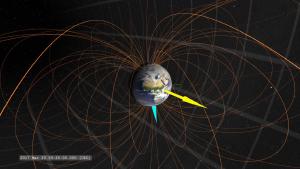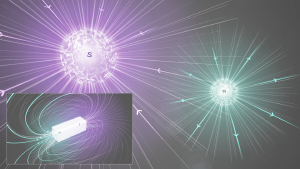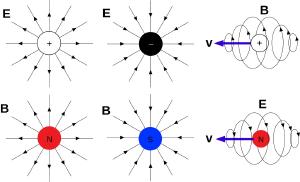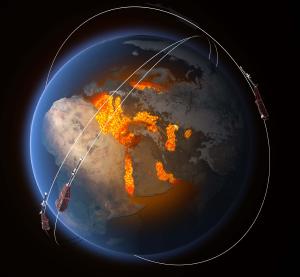Blog
Pole Position
19 March 2021
 NASA’s Scientific Visualization Studio
NASA’s Scientific Visualization StudioElectricity and magnetism have a lot in common. They are connected by the unified theory of electromagnetism, and are in many ways two sides of the same coin. Both can exert forces on charges and magnetic fields. A changing electric field creates a magnetic field and vice versa. Elementary particles can possess electric and magnetic properties. But there is one fundamental difference.
Electric fields are created by electric charges. There are two types of electric charge. We call positive and negative, and they exist independently. Electrons have just a negative charge, for example, while protons have a positive charge. The everyday objects around us are usually electrically neutral, but it’s easy to give objects a slight positive or negative charge. Static electricity is a good example of this.
 Daniel Dominguez, CERN
Daniel Dominguez, CERNThis is not the case with magnetic charge. Like electric charge, there are two types of magnetic charge. For historical reasons we call them north and south poles. But these magnetic poles always come in pairs. Every magnet has a north and south pole. If you break a magnet in half, you don’t separate the poles. Instead, you get two smaller magnets, each with a north and south pole. Even magnetic elementary particles have this dipole property. As far as we can tell, there are no magnetic monopoles.
 Wikipedia user Maschen
Wikipedia user MaschenAlthough we’ve never observed magnetic monopoles, we know what their properties would be according to electromagnetism. One of the more surprising consequences is that magnetic monopoles would quantize charge. If you had several electric and magnetic charges, the electromagnetic field they produce would have an angular momentum (rotation) that depends on the value of the electric and magnetic charges. In quantum mechanics, angular momentum is quantized, which means the charges would also be quantized. The existence of even one magnetic monopole in the universe would explain why fundamental particles always have an integral value of the electric charge. Magnetic monopoles would also bring symmetry to electromagnetism. This is one of the reasons why models such as string theory predict magnetic monopoles.
The discovery of magnetic monopoles would revolutionize our understanding of the universe, so it is worth looking for them where we can. Recently a team looked for evidence of them them in Earth’s magnetic field.1 In principle their idea is simple. If magnetic monopoles exist, they could be trapped by Earth’s strong magnetic field. This would give Earth a magnetic charge, which we should be able to measure.
 ESA/ATG Medialab
ESA/ATG MedialabIn practice, this is quite challenging. For their study, the team used six years of public data from the ESA’s Swarm constellation. This is a collection of orbiting satellites specifically designed to make a high-resolution map of Earth’s magnetic fields. From this data, the team created a map of our planet’s magnetic field lines and applied a mathematical technique known as Gauss’ Law. Think of the Earth surrounded by an imaginary sphere. If there are no magnetic monopoles, any magnetic field line that crosses out of the sphere must also cross back into the sphere. If there are magnetic monopoles, then some magnetic field lines must cross the sphere without crossing back. An excess of field line crossings would prove the existence of magnetic monopoles.
The team found that to the limits of their data there was no evidence of excess field line crossings. This doesn’t mean that magnetic monopoles don’t exist, just that there is no evidence of any being trapped by Earth’s magnetic field. So no luck this time, but it’s a great result using public data.
Bai, Yang, Sida Lu, and Nicholas Orlofsky. “Searching for Magnetic Monopoles with the Earth’s Magnetic Field.” arXiv preprint arXiv:2103.06286 (2021). ↩︎